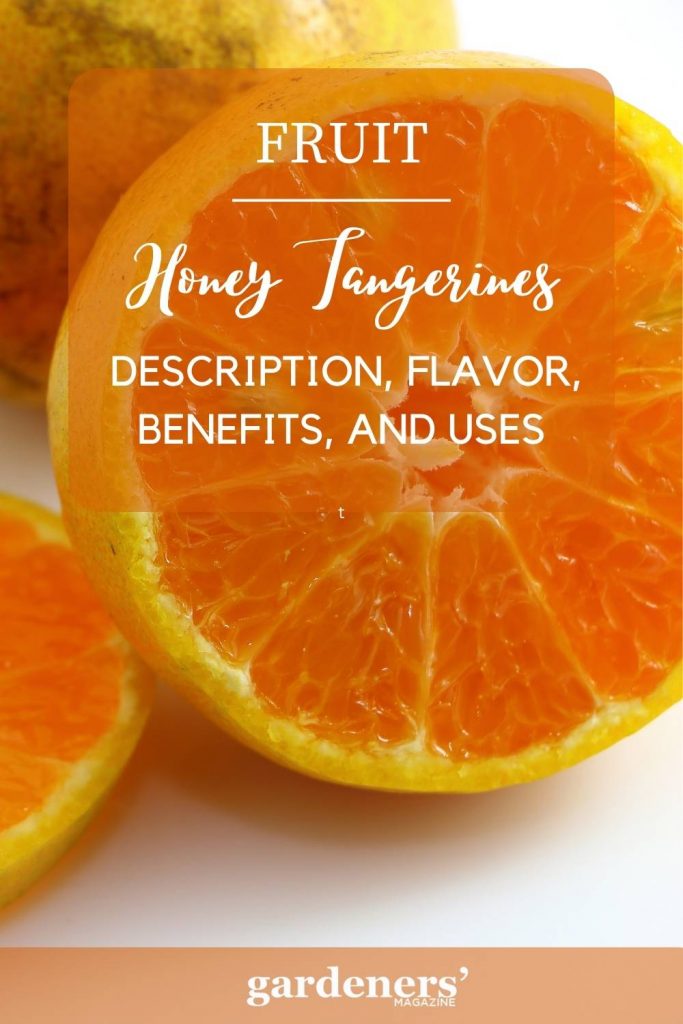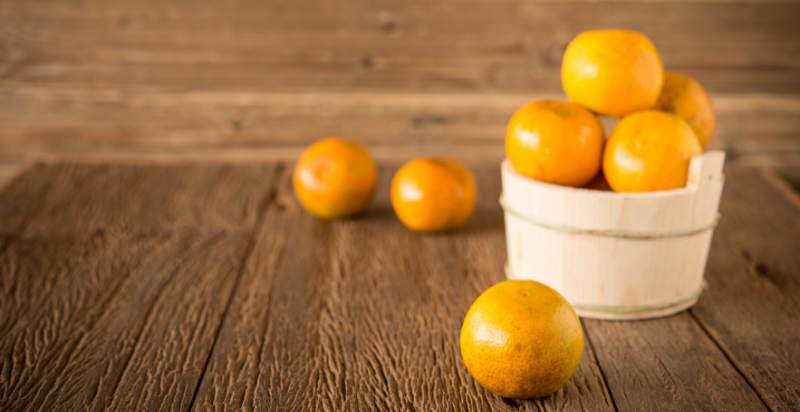Honey tangerines are a citrus fruit closely related to oranges and mandarins. They are smaller than oranges, with thin, yellow-orange skin and a sweet flavor. The fruit is sometimes referred to as “honey bell tangerines” or “minneolas” due to the bell-shaped end. Honey tangerines are a hybrid citrus fruit developed through cross-pollination of two other varieties – Dancy and Orlando tangelos. Here is everything you need to know about honey tangerines.
What are Honey Tangerines?
Honey tangerines are a hybrid citrus fruit known as Murcott, Honey Sweet, or Fallglo. They result from a cross between two tangerine varieties—the Dancy and the Orlando. The flesh of a honey tangerine is pale orange, very sweet, juicy, and full of flavor. They are considered a terrific snack because of their sweet taste and small size. Honey tangerines are high in vitamin C, fiber, potassium, and other minerals. They also contain antioxidants that can help protect against cancer and heart disease. Also, honey tangerines have fewer calories than other types of fruit, making them an excellent choice for people trying to lose weight.

History and Origin of Honey Tangerines
Honey tangerines are a cultivar of citrus fruit, believed to be a hybrid of the Dancy tangerine and willow leaf mandarin. It was first discovered in 1909 by W. T. Swingle, a horticulturist at the United States Department of Agriculture (USDA) research center in Orlando, Florida. The name was given to it due to its honey-like sweetness.
Honey tangerines have smooth, thin skin and were traditionally used for canning, marmalades, and juices. The tree is relatively small compared to other citrus varieties, making it a great choice for home gardens or patio container pots. They are also an ideal variety for home juicing, as they yield a large amount of juice and have an incredibly sweet taste. So next time you want to add some flavor to your recipes or ensure your family is getting their daily dose of vitamins, try using Honey Tangerines! They may just become your new favorite citrus fruit.
Description of Honey Tangerines
Honey tangerines are a variety of citrus fruit that are small in size, usually measuring between 4-6 cm (1.5 – 2.3 in) in diameter. The exterior skin of a honey tangerine is thin and easy to peel, with a slight yellowish hue and an overall smooth texture. The flesh of the honey tangerine is sweet, juicy, and flavorful. It is a great snack for kids and adults alike. Honey tangerines are a great source of vitamins A and C and dietary fiber. They can be eaten raw or used in jams, jellies, and dessert recipes. Honey tangerines can also be juiced for a refreshing drink.
Flavor Profile of Honey Tangerines
Compared to other citrus varieties, honey tangerines have a distinctive sweet-tart flavor. The sweetness is more intense than oranges, and the tartness is milder than lemons or limes. The texture of this variety is often described as juicy and tender, making them a delight to eat. Honey tangerines are also known for their intense fragrance, often described as floral and honey-like. These unique characteristics make honey tangerines ideal for fresh salads, smoothies, and juices. They also make a great topping or garnish for yogurt, ice cream, and other desserts.
Seasonality and Availability Throughout the Year of Honey Tangerines
Honey tangerines are available mainly from October to January in the United States. While they may be sporadically available through other months, the peak of their season is during late autumn to early winter. This availability makes them a great fruit to enjoy when citrus fruits are in season and at their peak flavor.
Health Benefits of Honey Tangerines
Honey tangerines are a great source of vitamins A and C and dietary fiber. They are also low in calories and free from fat or cholesterol. The dietary fiber found in honey tangerines helps keep the digestive system healthy, while Vitamin A benefits eye health. The high levels of Vitamin C also help to boost immunity and protect against illnesses. Honey tangerines can be enjoyed fresh, juiced, or topped with yogurt and other desserts. Not only are they tasty and nutritious, but they also make a great addition to any meal!
Cultivation of the Honey Tangerines
The honey tangerine tree is easy to cultivate and can be grown in home gardens. It prefers full sun but can tolerate some shade. The soil should be well-drained and slightly acidic with a pH of 5-6. When planting, dig a hole twice as large as the root ball and mix in compost or aged manure for added nutrients. Plant the tree at the same depth as it was in the pot. Water deeply and mulch around the tree’s base to conserve moisture and reduce weeds.
The honey tangerine tree has a low chill requirement, so it can be grown successfully in warmer climates, such as Florida or California, where other citrus trees may not thrive. Flowers bloom in spring, followed by fruit that ripens in late fall or early winter. To help encourage pollination, try planting two compatible varieties, the ‘Miyagawa’ and ‘Owari,’ together for increased fruit production.
Harvesting of the Honey Tangerines
Harvesting of Honey tangerines begins mid to late October and continues through early December. The fruit should be harvested when fully ripe, as the flavor will not improve once picked. It may be necessary to harvest fruit from multiple harvests over a few weeks, as some parts of the tree ripen faster than others.
When harvesting, the fruit should be handled gently to prevent bruising or damage. It can then be put into boxes or bags and packed for transport to the market. Sometimes, the fruit must be chilled before shipping to prevent spoilage.

Where do Honey Tangerines Grow?
Honey tangerines are grown in many tropical and subtropical regions around the world. They are especially popular in Southeast Asia, India, South Africa, Florida, California, and Brazil. In the U.S., honey tangerines are often found in grocery stores from October to April. The trees prefer warm climates with low humidity levels and plenty of sunlight.
In Florida, honey tangerines are mainly grown in the central and southern regions of the state. California’s Central Valley is also a major producer of this fruit. The warm climates of India and South Africa also provide ideal growing conditions for honey tangerines.
What are the things to remember when buying Honey Tangerines?
- Choose Honey tangerines that are plump and firm with bright orange, glossy skin. Avoid those that have any green or yellow patches, as these can indicate they were picked prematurely.
- Smell the tangerine! If it has a sweet aroma, it is ripe and ready to eat.
- Shake the tangerine to ensure it is not too soft or mushy.
- If you are buying Honey tangerines in bulk, inspect each one to ensure there are no spoiled fruits.
These are some important things to keep in mind when buying Honey tangerines. With these tips, you can ensure that you always get the best possible fruit.
What is the best way to Store Honey Tangerines?
The best way to store Honey tangerines is in a cool, dry, and dark place. It would help if you avoided moisture, so keep them away from any sources of humidity, such as bathrooms or kitchens. Place the fruit in a paper bag with several holes punched to allow for air circulation, and store it in a refrigerator or similar climate-controlled area.
If you cannot store the Honey tangerines in a cool and dry place, you can keep them at room temperature but away from sunlight. Make sure to check on them regularly for mold or other signs of spoilage. They should generally last between two to three weeks if stored correctly.
How can Honey Tangerines be used in Recipes with other Fruits and Vegetables?
Honey tangerines can be used in various recipes to add sweetness and flavor. They are especially delicious when combined with apples, oranges, or pineapples. They can also add extra zest to salads, salsas, and stir-fries. Honey tangerines pair excellently with carrots, broccoli, peppers, and onions.
Their mild sweetness can also create unique marinades for poultry and meats. The possibilities are endless when it comes to using honey tangerines in recipes! Combine them with your favorite ingredients for a delicious meal you want to make repeatedly.
Conclusion
Honey tangerines are a delicious and versatile fruit that can be enjoyed in various ways. When selecting them at the store or market, look for ones that are firm to the touch with no signs of damage or soft spots. Storing them correctly ensures they stay fresh and taste their best. Finally, honey tangerines can be used in various recipes, from salads and salsas to marinades and stir-fries. Enjoy the sweet citrus goodness of this unique fruit!
- Everything You Wanted to Know About Red Tamarillos - June 2, 2025
- A Guide to Tulips: Everything You Need to Know & More… - June 2, 2025
- Guanabana: Description, Flavor, Benefits, And Uses - May 27, 2025

4 thoughts on “Honey Tangerines: Description, Flavor, Benefits, And Uses”
Comments are closed.